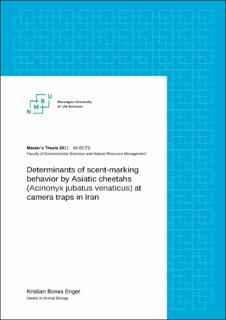| dc.contributor.advisor | Bischof, Richard | |
| dc.contributor.advisor | Mohammadi Moqanaki, Ehsan | |
| dc.contributor.author | Enger, Kristian Bones | |
| dc.coverage.spatial | Iran | en_US |
| dc.date.accessioned | 2021-11-26T12:33:42Z | |
| dc.date.available | 2021-11-26T12:33:42Z | |
| dc.date.issued | 2021 | |
| dc.identifier.uri | https://hdl.handle.net/11250/2831674 | |
| dc.description.abstract | Scent marking is a common behaviour in large carnivores and serves a multiple of ecological purposes. It functions as a method of communication, either to warn off intruders, attract mates or to mark territory. In surveys and monitoring of rare and elusive carnivores, understanding predictors for where and why the target species scent mark in a certain spot can help to optimize the sampling method. By studying scent marking behaviour of large carnivores in situ, it is possible to link the potential ecological determinants with where one might most likely spot an individual to increase the probability of detection.
In this study, I focused on the scent marking behaviour in Asiatic cheetahs (Acinonyx jubatus venaticus) in Iran. The Asiatic cheetah is considered critically endangered, with a population that has significantly declined over the years. I analysed images and video footage taken by trail cameras from 321 stations across nine study areas in Iran during 2009-2014. I collated behavioural data for the individuals that were detected, and environmental data from their surroundings to explore factors influencing the scent-marking behaviour at camera trap locations. In addition, I fitted an occupancy model to the data to estimate the probabilities of detection and site occupancy by cheetahs.
The results showed that: (1) Asiatic cheetahs’ detection probability was very low (p = 0.03; 95% CI =0.02-0.03); (2) detection of cheetah scent marking behaviour at camera traps was positively correlated with presence of marking trees and distance to the nearest water source, with tree presence always resulting as a significant variable.
I will discuss the relevance of my findings to the Asiatic cheetah’s research and conservation, providing ideas for refining the current monitoring program for the future. | en_US |
| dc.language.iso | eng | en_US |
| dc.publisher | Norwegian University of Life Sciences, Ås | en_US |
| dc.rights | Attribution-NonCommercial-NoDerivatives 4.0 Internasjonal | * |
| dc.rights.uri | http://creativecommons.org/licenses/by-nc-nd/4.0/deed.no | * |
| dc.title | Determinants of scent-marking behavior by Asiatic cheetahs (Acinonyx jubatus venaticus) at camera traps in Iran | en_US |
| dc.type | Master thesis | en_US |
| dc.description.localcode | M-BIOL | en_US |

